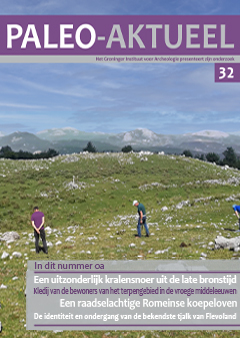Vetwinning in de Swifterbantcultuur. Een interpretatie van een vindplaats te Nieuwegein-Beatrixsluis
DOI:
https://doi.org/10.21827/PA.32.1-6Samenvatting
Fat rendering at a Swifterbant site at Nieuwegein Beatrixsluis. An archaeological site near the Beatrixsluis locks at Nieuwegein, in the province of Utrecht, is interpreted with the aid of ethno-archaeological parallels as a location for bone-fat extraction. The site, radiocarbon-dated as belonging to the Swifterbant culture (5300-3400 BC), was situated on the southern slope of a natural levee of the Benschop river. The archaeological artefacts, consisting mostly of a large amount of fragmented animal bones and a few pieces of flint and pottery, were found near a surface hearth. The most striking feature of these animal bones was the severe fragmentation whereby almost all of the bones had been burned. A comparison for this extensive fragmentation is found in ethno-archaeological descriptions of bone-fat extraction. The most distinctive criteria for this process are similar to the bone remains at Nieuwegein: the high level of fragmentation, the types of bones and the type of species. Therefore the site is interpreted as a location for bone-fat extraction from bones of presumably domesticated animals. Given the spatial patterns, this fat rendering was performed during the winter months, possibly by the inhabitants of the nearby Swifterbant site of “Het Klooster” to supplement a dearth of animal fat for either consumption or other uses.

